HIST 1301-1302: Analyzing the Philadelphia Convention of 1787
VerifiedAdded on 2023/05/29
|9
|2156
|180
Essay
AI Summary
This essay explores the historical backdrop and key provisions of the Philadelphia Convention of 1787, a pivotal event in US Constitutional History. It examines the weaknesses of the Articles of Confederation that led to the convention and the debates surrounding the creation of a new constitutional framework. The essay discusses the Virginia Plan, the New Jersey Plan, and the compromises reached concerning issues like slavery and states' rights. It argues that while the convention aimed to create a strong, unified national government, the resulting constitution was weakened by concessions to Southern states, limiting the power of the American Congress and preserving significant autonomy for individual states. Despite efforts to address national issues, the influence of states, particularly on matters like slave trade, persisted, hindering the establishment of a truly unified and powerful national government. Desklib offers a wealth of similar solved assignments and past papers to aid students in their studies.
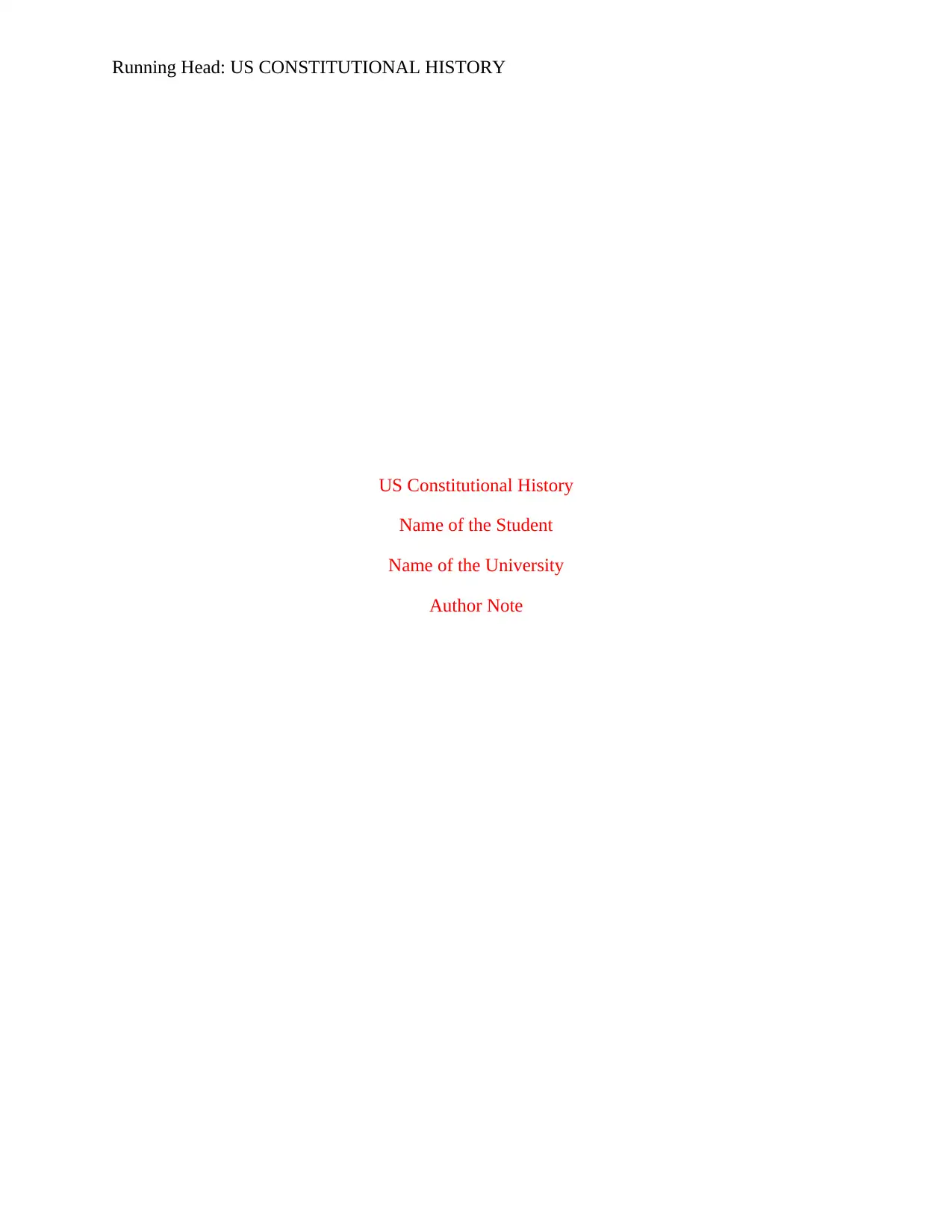
Running Head: US CONSTITUTIONAL HISTORY
US Constitutional History
Name of the Student
Name of the University
Author Note
US Constitutional History
Name of the Student
Name of the University
Author Note
Paraphrase This Document
Need a fresh take? Get an instant paraphrase of this document with our AI Paraphraser
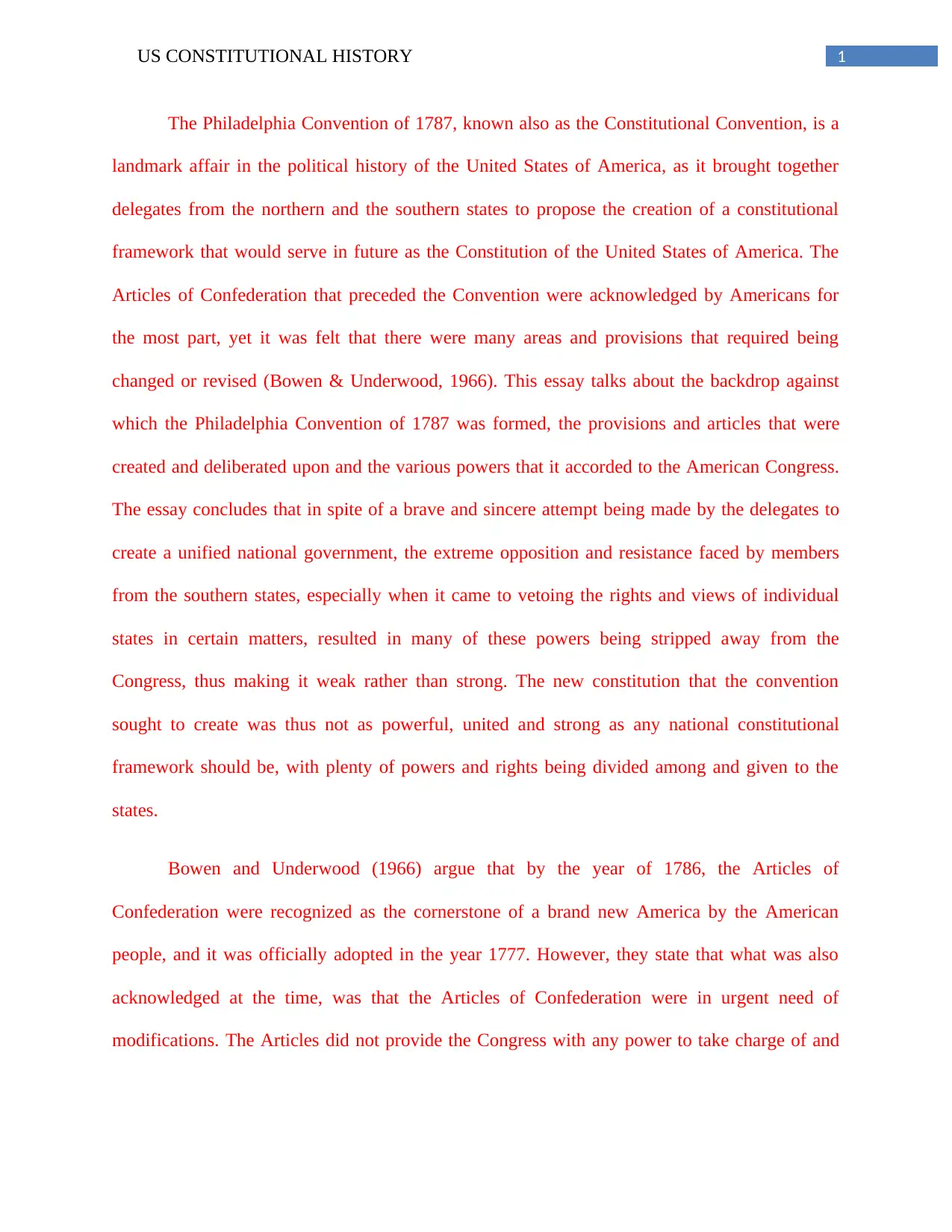
1US CONSTITUTIONAL HISTORY
The Philadelphia Convention of 1787, known also as the Constitutional Convention, is a
landmark affair in the political history of the United States of America, as it brought together
delegates from the northern and the southern states to propose the creation of a constitutional
framework that would serve in future as the Constitution of the United States of America. The
Articles of Confederation that preceded the Convention were acknowledged by Americans for
the most part, yet it was felt that there were many areas and provisions that required being
changed or revised (Bowen & Underwood, 1966). This essay talks about the backdrop against
which the Philadelphia Convention of 1787 was formed, the provisions and articles that were
created and deliberated upon and the various powers that it accorded to the American Congress.
The essay concludes that in spite of a brave and sincere attempt being made by the delegates to
create a unified national government, the extreme opposition and resistance faced by members
from the southern states, especially when it came to vetoing the rights and views of individual
states in certain matters, resulted in many of these powers being stripped away from the
Congress, thus making it weak rather than strong. The new constitution that the convention
sought to create was thus not as powerful, united and strong as any national constitutional
framework should be, with plenty of powers and rights being divided among and given to the
states.
Bowen and Underwood (1966) argue that by the year of 1786, the Articles of
Confederation were recognized as the cornerstone of a brand new America by the American
people, and it was officially adopted in the year 1777. However, they state that what was also
acknowledged at the time, was that the Articles of Confederation were in urgent need of
modifications. The Articles did not provide the Congress with any power to take charge of and
The Philadelphia Convention of 1787, known also as the Constitutional Convention, is a
landmark affair in the political history of the United States of America, as it brought together
delegates from the northern and the southern states to propose the creation of a constitutional
framework that would serve in future as the Constitution of the United States of America. The
Articles of Confederation that preceded the Convention were acknowledged by Americans for
the most part, yet it was felt that there were many areas and provisions that required being
changed or revised (Bowen & Underwood, 1966). This essay talks about the backdrop against
which the Philadelphia Convention of 1787 was formed, the provisions and articles that were
created and deliberated upon and the various powers that it accorded to the American Congress.
The essay concludes that in spite of a brave and sincere attempt being made by the delegates to
create a unified national government, the extreme opposition and resistance faced by members
from the southern states, especially when it came to vetoing the rights and views of individual
states in certain matters, resulted in many of these powers being stripped away from the
Congress, thus making it weak rather than strong. The new constitution that the convention
sought to create was thus not as powerful, united and strong as any national constitutional
framework should be, with plenty of powers and rights being divided among and given to the
states.
Bowen and Underwood (1966) argue that by the year of 1786, the Articles of
Confederation were recognized as the cornerstone of a brand new America by the American
people, and it was officially adopted in the year 1777. However, they state that what was also
acknowledged at the time, was that the Articles of Confederation were in urgent need of
modifications. The Articles did not provide the Congress with any power to take charge of and
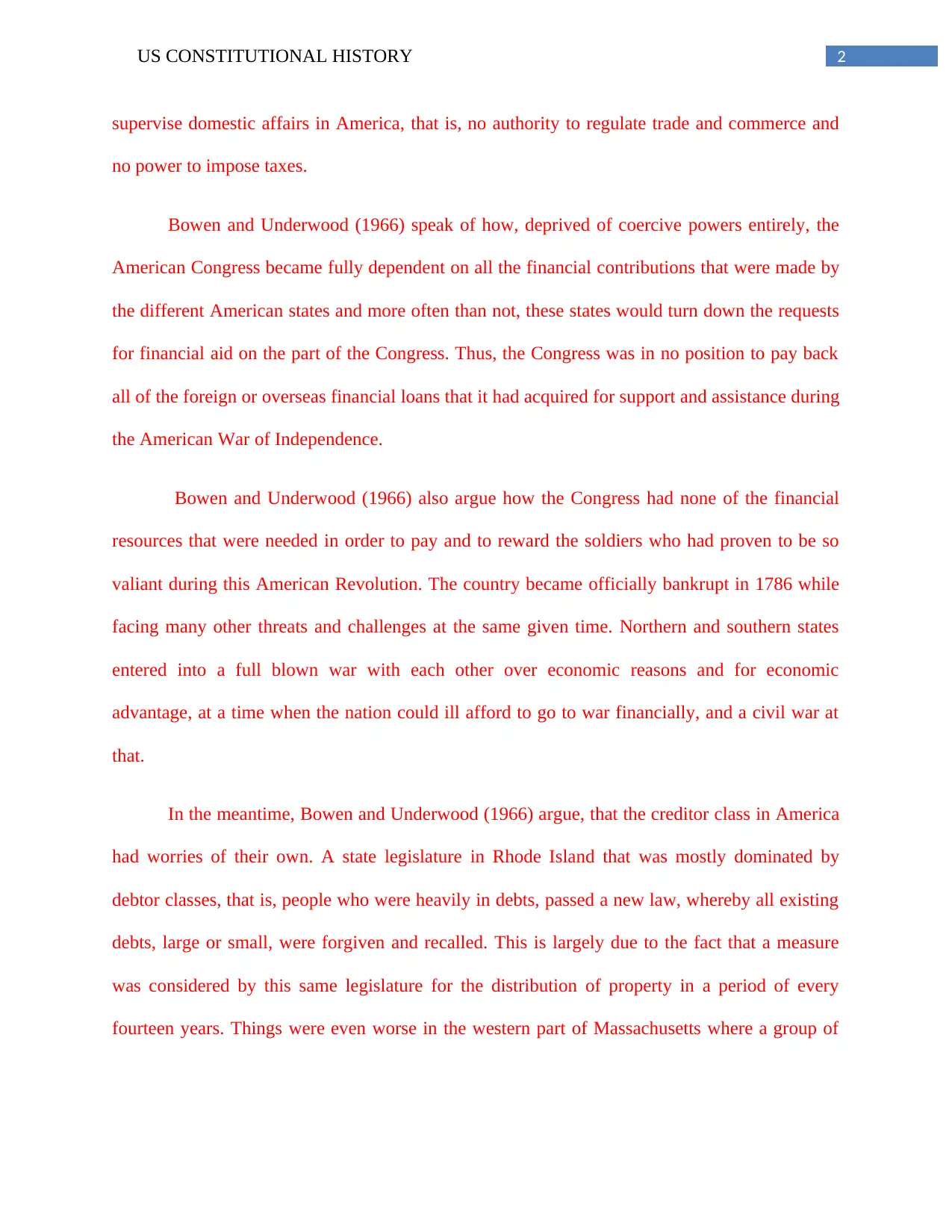
2US CONSTITUTIONAL HISTORY
supervise domestic affairs in America, that is, no authority to regulate trade and commerce and
no power to impose taxes.
Bowen and Underwood (1966) speak of how, deprived of coercive powers entirely, the
American Congress became fully dependent on all the financial contributions that were made by
the different American states and more often than not, these states would turn down the requests
for financial aid on the part of the Congress. Thus, the Congress was in no position to pay back
all of the foreign or overseas financial loans that it had acquired for support and assistance during
the American War of Independence.
Bowen and Underwood (1966) also argue how the Congress had none of the financial
resources that were needed in order to pay and to reward the soldiers who had proven to be so
valiant during this American Revolution. The country became officially bankrupt in 1786 while
facing many other threats and challenges at the same given time. Northern and southern states
entered into a full blown war with each other over economic reasons and for economic
advantage, at a time when the nation could ill afford to go to war financially, and a civil war at
that.
In the meantime, Bowen and Underwood (1966) argue, that the creditor class in America
had worries of their own. A state legislature in Rhode Island that was mostly dominated by
debtor classes, that is, people who were heavily in debts, passed a new law, whereby all existing
debts, large or small, were forgiven and recalled. This is largely due to the fact that a measure
was considered by this same legislature for the distribution of property in a period of every
fourteen years. Things were even worse in the western part of Massachusetts where a group of
supervise domestic affairs in America, that is, no authority to regulate trade and commerce and
no power to impose taxes.
Bowen and Underwood (1966) speak of how, deprived of coercive powers entirely, the
American Congress became fully dependent on all the financial contributions that were made by
the different American states and more often than not, these states would turn down the requests
for financial aid on the part of the Congress. Thus, the Congress was in no position to pay back
all of the foreign or overseas financial loans that it had acquired for support and assistance during
the American War of Independence.
Bowen and Underwood (1966) also argue how the Congress had none of the financial
resources that were needed in order to pay and to reward the soldiers who had proven to be so
valiant during this American Revolution. The country became officially bankrupt in 1786 while
facing many other threats and challenges at the same given time. Northern and southern states
entered into a full blown war with each other over economic reasons and for economic
advantage, at a time when the nation could ill afford to go to war financially, and a civil war at
that.
In the meantime, Bowen and Underwood (1966) argue, that the creditor class in America
had worries of their own. A state legislature in Rhode Island that was mostly dominated by
debtor classes, that is, people who were heavily in debts, passed a new law, whereby all existing
debts, large or small, were forgiven and recalled. This is largely due to the fact that a measure
was considered by this same legislature for the distribution of property in a period of every
fourteen years. Things were even worse in the western part of Massachusetts where a group of
⊘ This is a preview!⊘
Do you want full access?
Subscribe today to unlock all pages.

Trusted by 1+ million students worldwide
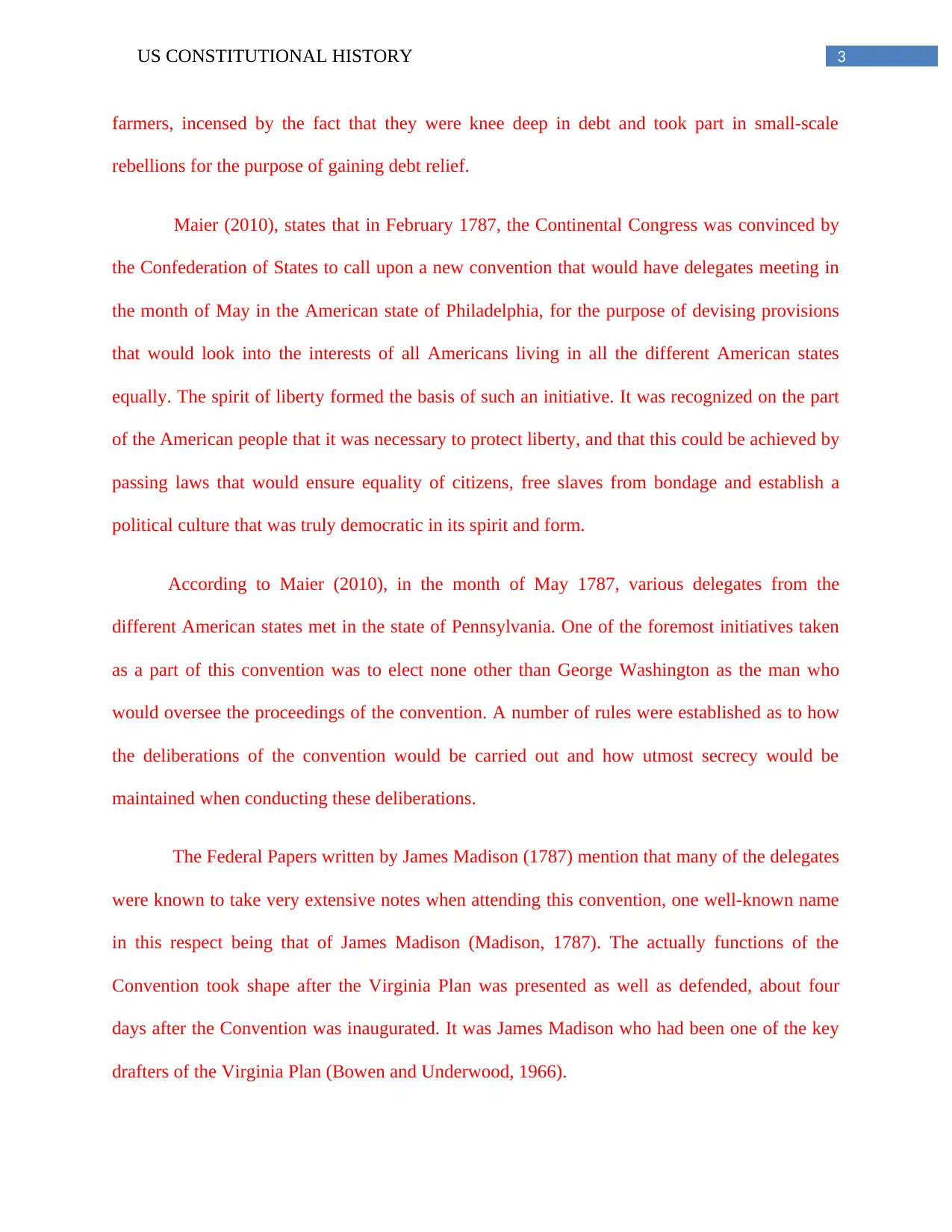
3US CONSTITUTIONAL HISTORY
farmers, incensed by the fact that they were knee deep in debt and took part in small-scale
rebellions for the purpose of gaining debt relief.
Maier (2010), states that in February 1787, the Continental Congress was convinced by
the Confederation of States to call upon a new convention that would have delegates meeting in
the month of May in the American state of Philadelphia, for the purpose of devising provisions
that would look into the interests of all Americans living in all the different American states
equally. The spirit of liberty formed the basis of such an initiative. It was recognized on the part
of the American people that it was necessary to protect liberty, and that this could be achieved by
passing laws that would ensure equality of citizens, free slaves from bondage and establish a
political culture that was truly democratic in its spirit and form.
According to Maier (2010), in the month of May 1787, various delegates from the
different American states met in the state of Pennsylvania. One of the foremost initiatives taken
as a part of this convention was to elect none other than George Washington as the man who
would oversee the proceedings of the convention. A number of rules were established as to how
the deliberations of the convention would be carried out and how utmost secrecy would be
maintained when conducting these deliberations.
The Federal Papers written by James Madison (1787) mention that many of the delegates
were known to take very extensive notes when attending this convention, one well-known name
in this respect being that of James Madison (Madison, 1787). The actually functions of the
Convention took shape after the Virginia Plan was presented as well as defended, about four
days after the Convention was inaugurated. It was James Madison who had been one of the key
drafters of the Virginia Plan (Bowen and Underwood, 1966).
farmers, incensed by the fact that they were knee deep in debt and took part in small-scale
rebellions for the purpose of gaining debt relief.
Maier (2010), states that in February 1787, the Continental Congress was convinced by
the Confederation of States to call upon a new convention that would have delegates meeting in
the month of May in the American state of Philadelphia, for the purpose of devising provisions
that would look into the interests of all Americans living in all the different American states
equally. The spirit of liberty formed the basis of such an initiative. It was recognized on the part
of the American people that it was necessary to protect liberty, and that this could be achieved by
passing laws that would ensure equality of citizens, free slaves from bondage and establish a
political culture that was truly democratic in its spirit and form.
According to Maier (2010), in the month of May 1787, various delegates from the
different American states met in the state of Pennsylvania. One of the foremost initiatives taken
as a part of this convention was to elect none other than George Washington as the man who
would oversee the proceedings of the convention. A number of rules were established as to how
the deliberations of the convention would be carried out and how utmost secrecy would be
maintained when conducting these deliberations.
The Federal Papers written by James Madison (1787) mention that many of the delegates
were known to take very extensive notes when attending this convention, one well-known name
in this respect being that of James Madison (Madison, 1787). The actually functions of the
Convention took shape after the Virginia Plan was presented as well as defended, about four
days after the Convention was inaugurated. It was James Madison who had been one of the key
drafters of the Virginia Plan (Bowen and Underwood, 1966).
Paraphrase This Document
Need a fresh take? Get an instant paraphrase of this document with our AI Paraphraser
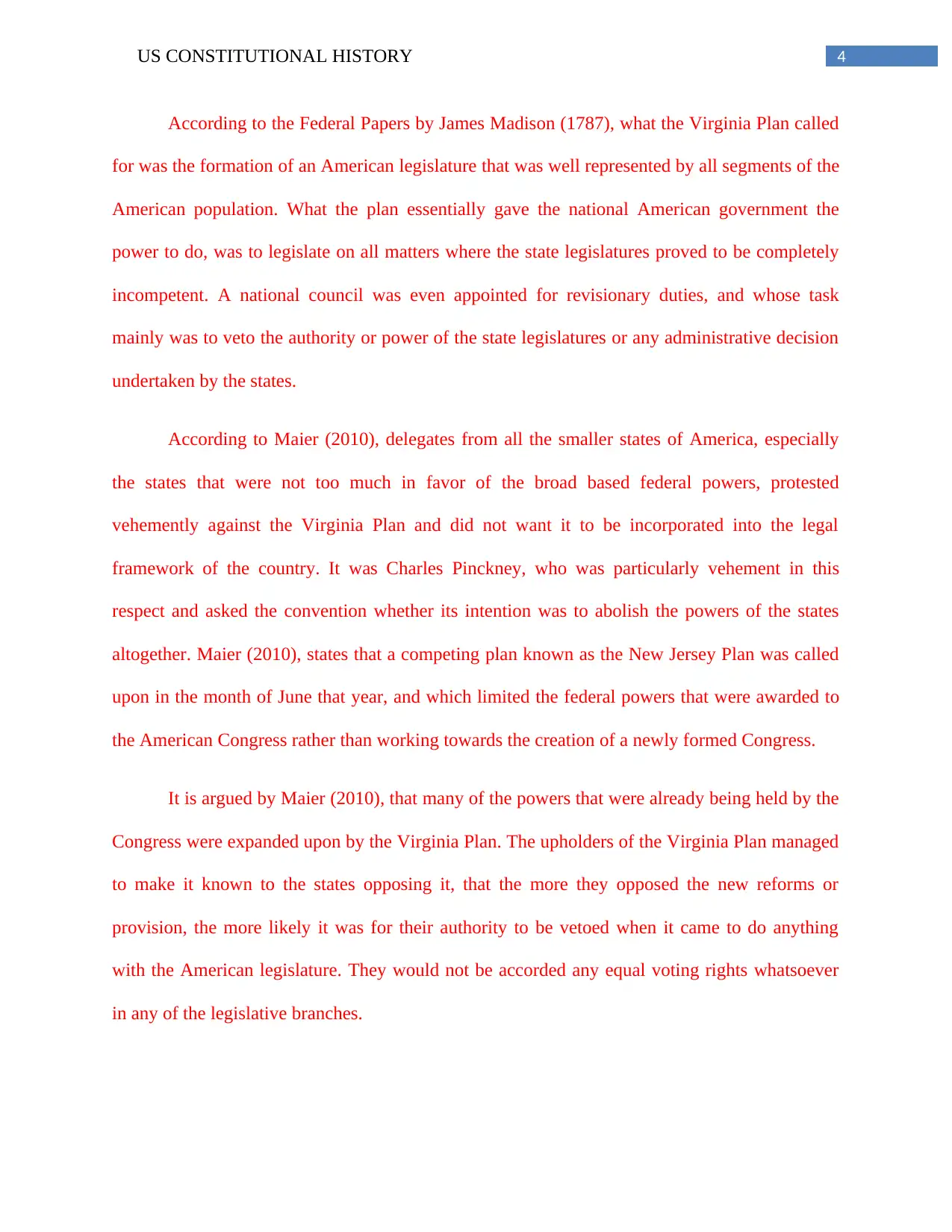
4US CONSTITUTIONAL HISTORY
According to the Federal Papers by James Madison (1787), what the Virginia Plan called
for was the formation of an American legislature that was well represented by all segments of the
American population. What the plan essentially gave the national American government the
power to do, was to legislate on all matters where the state legislatures proved to be completely
incompetent. A national council was even appointed for revisionary duties, and whose task
mainly was to veto the authority or power of the state legislatures or any administrative decision
undertaken by the states.
According to Maier (2010), delegates from all the smaller states of America, especially
the states that were not too much in favor of the broad based federal powers, protested
vehemently against the Virginia Plan and did not want it to be incorporated into the legal
framework of the country. It was Charles Pinckney, who was particularly vehement in this
respect and asked the convention whether its intention was to abolish the powers of the states
altogether. Maier (2010), states that a competing plan known as the New Jersey Plan was called
upon in the month of June that year, and which limited the federal powers that were awarded to
the American Congress rather than working towards the creation of a newly formed Congress.
It is argued by Maier (2010), that many of the powers that were already being held by the
Congress were expanded upon by the Virginia Plan. The upholders of the Virginia Plan managed
to make it known to the states opposing it, that the more they opposed the new reforms or
provision, the more likely it was for their authority to be vetoed when it came to do anything
with the American legislature. They would not be accorded any equal voting rights whatsoever
in any of the legislative branches.
According to the Federal Papers by James Madison (1787), what the Virginia Plan called
for was the formation of an American legislature that was well represented by all segments of the
American population. What the plan essentially gave the national American government the
power to do, was to legislate on all matters where the state legislatures proved to be completely
incompetent. A national council was even appointed for revisionary duties, and whose task
mainly was to veto the authority or power of the state legislatures or any administrative decision
undertaken by the states.
According to Maier (2010), delegates from all the smaller states of America, especially
the states that were not too much in favor of the broad based federal powers, protested
vehemently against the Virginia Plan and did not want it to be incorporated into the legal
framework of the country. It was Charles Pinckney, who was particularly vehement in this
respect and asked the convention whether its intention was to abolish the powers of the states
altogether. Maier (2010), states that a competing plan known as the New Jersey Plan was called
upon in the month of June that year, and which limited the federal powers that were awarded to
the American Congress rather than working towards the creation of a newly formed Congress.
It is argued by Maier (2010), that many of the powers that were already being held by the
Congress were expanded upon by the Virginia Plan. The upholders of the Virginia Plan managed
to make it known to the states opposing it, that the more they opposed the new reforms or
provision, the more likely it was for their authority to be vetoed when it came to do anything
with the American legislature. They would not be accorded any equal voting rights whatsoever
in any of the legislative branches.
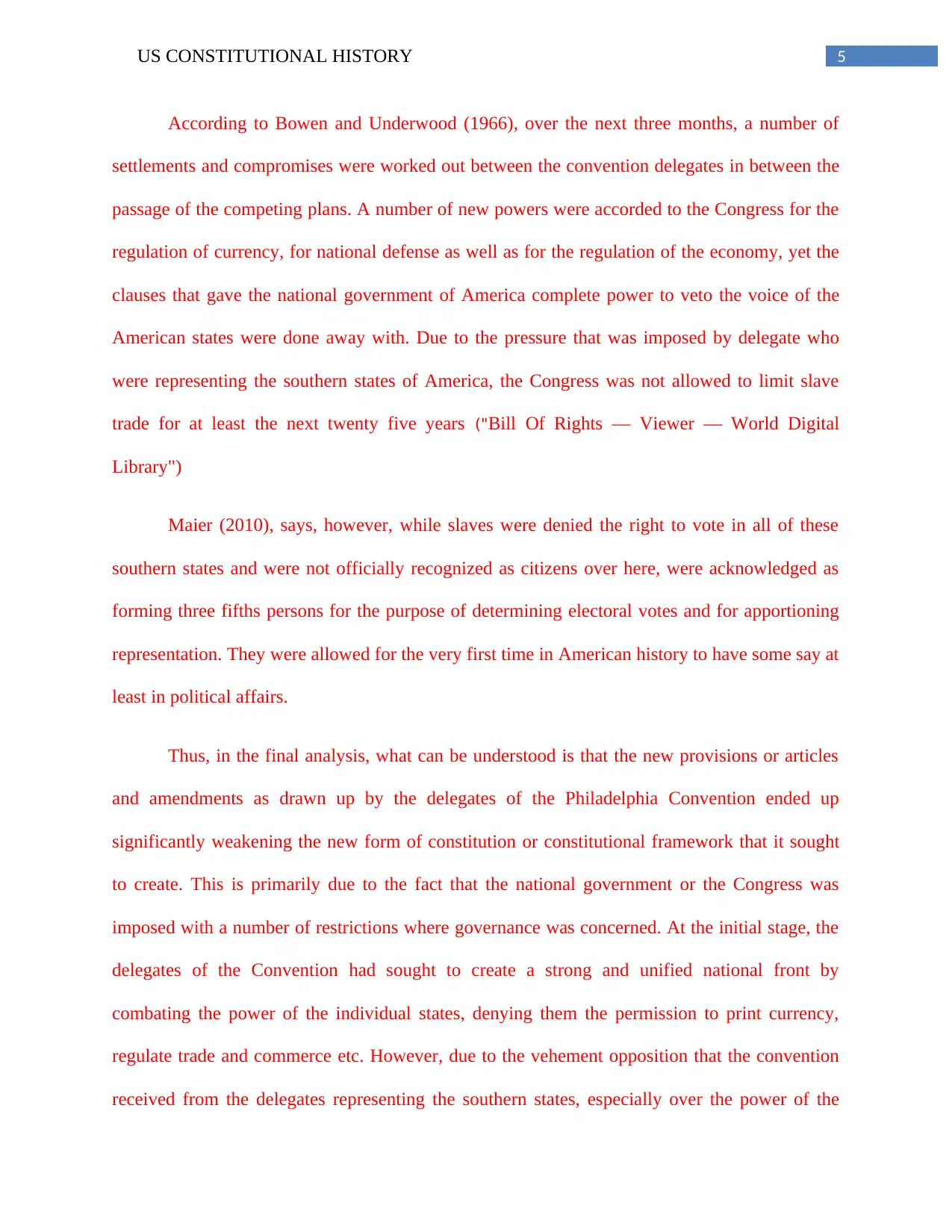
5US CONSTITUTIONAL HISTORY
According to Bowen and Underwood (1966), over the next three months, a number of
settlements and compromises were worked out between the convention delegates in between the
passage of the competing plans. A number of new powers were accorded to the Congress for the
regulation of currency, for national defense as well as for the regulation of the economy, yet the
clauses that gave the national government of America complete power to veto the voice of the
American states were done away with. Due to the pressure that was imposed by delegate who
were representing the southern states of America, the Congress was not allowed to limit slave
trade for at least the next twenty five years ("Bill Of Rights — Viewer — World Digital
Library")
Maier (2010), says, however, while slaves were denied the right to vote in all of these
southern states and were not officially recognized as citizens over here, were acknowledged as
forming three fifths persons for the purpose of determining electoral votes and for apportioning
representation. They were allowed for the very first time in American history to have some say at
least in political affairs.
Thus, in the final analysis, what can be understood is that the new provisions or articles
and amendments as drawn up by the delegates of the Philadelphia Convention ended up
significantly weakening the new form of constitution or constitutional framework that it sought
to create. This is primarily due to the fact that the national government or the Congress was
imposed with a number of restrictions where governance was concerned. At the initial stage, the
delegates of the Convention had sought to create a strong and unified national front by
combating the power of the individual states, denying them the permission to print currency,
regulate trade and commerce etc. However, due to the vehement opposition that the convention
received from the delegates representing the southern states, especially over the power of the
According to Bowen and Underwood (1966), over the next three months, a number of
settlements and compromises were worked out between the convention delegates in between the
passage of the competing plans. A number of new powers were accorded to the Congress for the
regulation of currency, for national defense as well as for the regulation of the economy, yet the
clauses that gave the national government of America complete power to veto the voice of the
American states were done away with. Due to the pressure that was imposed by delegate who
were representing the southern states of America, the Congress was not allowed to limit slave
trade for at least the next twenty five years ("Bill Of Rights — Viewer — World Digital
Library")
Maier (2010), says, however, while slaves were denied the right to vote in all of these
southern states and were not officially recognized as citizens over here, were acknowledged as
forming three fifths persons for the purpose of determining electoral votes and for apportioning
representation. They were allowed for the very first time in American history to have some say at
least in political affairs.
Thus, in the final analysis, what can be understood is that the new provisions or articles
and amendments as drawn up by the delegates of the Philadelphia Convention ended up
significantly weakening the new form of constitution or constitutional framework that it sought
to create. This is primarily due to the fact that the national government or the Congress was
imposed with a number of restrictions where governance was concerned. At the initial stage, the
delegates of the Convention had sought to create a strong and unified national front by
combating the power of the individual states, denying them the permission to print currency,
regulate trade and commerce etc. However, due to the vehement opposition that the convention
received from the delegates representing the southern states, especially over the power of the
⊘ This is a preview!⊘
Do you want full access?
Subscribe today to unlock all pages.

Trusted by 1+ million students worldwide
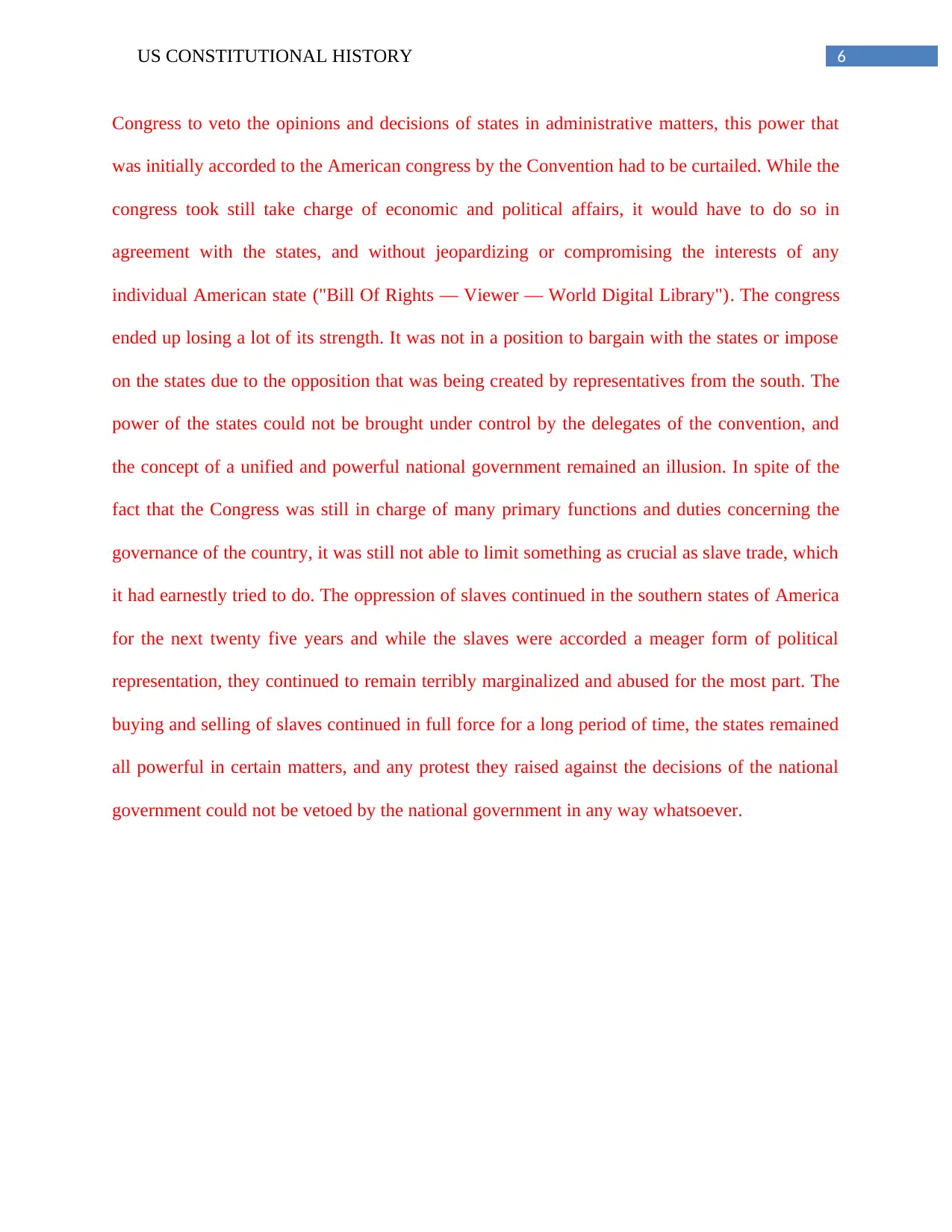
6US CONSTITUTIONAL HISTORY
Congress to veto the opinions and decisions of states in administrative matters, this power that
was initially accorded to the American congress by the Convention had to be curtailed. While the
congress took still take charge of economic and political affairs, it would have to do so in
agreement with the states, and without jeopardizing or compromising the interests of any
individual American state ("Bill Of Rights — Viewer — World Digital Library"). The congress
ended up losing a lot of its strength. It was not in a position to bargain with the states or impose
on the states due to the opposition that was being created by representatives from the south. The
power of the states could not be brought under control by the delegates of the convention, and
the concept of a unified and powerful national government remained an illusion. In spite of the
fact that the Congress was still in charge of many primary functions and duties concerning the
governance of the country, it was still not able to limit something as crucial as slave trade, which
it had earnestly tried to do. The oppression of slaves continued in the southern states of America
for the next twenty five years and while the slaves were accorded a meager form of political
representation, they continued to remain terribly marginalized and abused for the most part. The
buying and selling of slaves continued in full force for a long period of time, the states remained
all powerful in certain matters, and any protest they raised against the decisions of the national
government could not be vetoed by the national government in any way whatsoever.
Congress to veto the opinions and decisions of states in administrative matters, this power that
was initially accorded to the American congress by the Convention had to be curtailed. While the
congress took still take charge of economic and political affairs, it would have to do so in
agreement with the states, and without jeopardizing or compromising the interests of any
individual American state ("Bill Of Rights — Viewer — World Digital Library"). The congress
ended up losing a lot of its strength. It was not in a position to bargain with the states or impose
on the states due to the opposition that was being created by representatives from the south. The
power of the states could not be brought under control by the delegates of the convention, and
the concept of a unified and powerful national government remained an illusion. In spite of the
fact that the Congress was still in charge of many primary functions and duties concerning the
governance of the country, it was still not able to limit something as crucial as slave trade, which
it had earnestly tried to do. The oppression of slaves continued in the southern states of America
for the next twenty five years and while the slaves were accorded a meager form of political
representation, they continued to remain terribly marginalized and abused for the most part. The
buying and selling of slaves continued in full force for a long period of time, the states remained
all powerful in certain matters, and any protest they raised against the decisions of the national
government could not be vetoed by the national government in any way whatsoever.
Paraphrase This Document
Need a fresh take? Get an instant paraphrase of this document with our AI Paraphraser
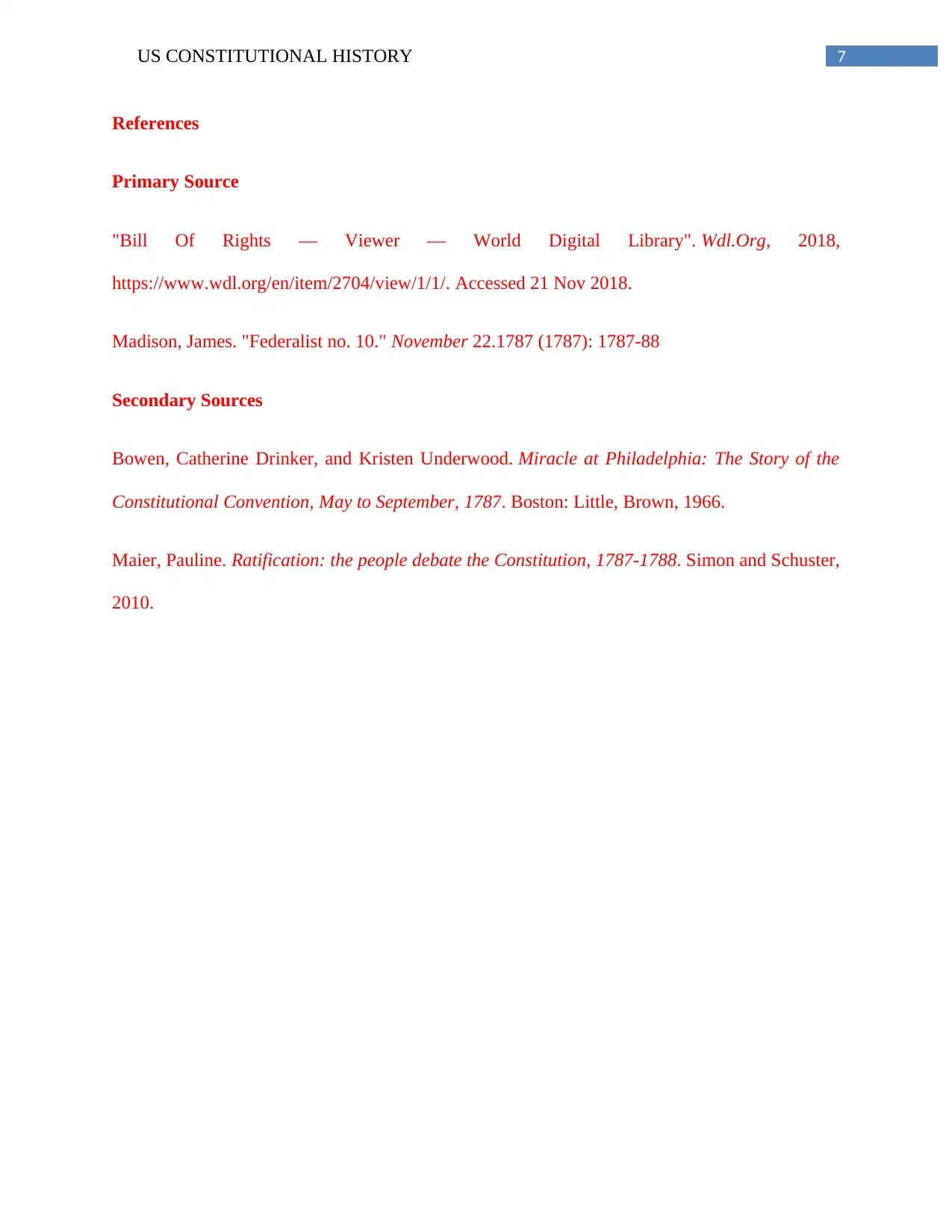
7US CONSTITUTIONAL HISTORY
References
Primary Source
"Bill Of Rights — Viewer — World Digital Library". Wdl.Org, 2018,
https://www.wdl.org/en/item/2704/view/1/1/. Accessed 21 Nov 2018.
Madison, James. "Federalist no. 10." November 22.1787 (1787): 1787-88
Secondary Sources
Bowen, Catherine Drinker, and Kristen Underwood. Miracle at Philadelphia: The Story of the
Constitutional Convention, May to September, 1787. Boston: Little, Brown, 1966.
Maier, Pauline. Ratification: the people debate the Constitution, 1787-1788. Simon and Schuster,
2010.
References
Primary Source
"Bill Of Rights — Viewer — World Digital Library". Wdl.Org, 2018,
https://www.wdl.org/en/item/2704/view/1/1/. Accessed 21 Nov 2018.
Madison, James. "Federalist no. 10." November 22.1787 (1787): 1787-88
Secondary Sources
Bowen, Catherine Drinker, and Kristen Underwood. Miracle at Philadelphia: The Story of the
Constitutional Convention, May to September, 1787. Boston: Little, Brown, 1966.
Maier, Pauline. Ratification: the people debate the Constitution, 1787-1788. Simon and Schuster,
2010.

8US CONSTITUTIONAL HISTORY
⊘ This is a preview!⊘
Do you want full access?
Subscribe today to unlock all pages.

Trusted by 1+ million students worldwide
1 out of 9
Related Documents
Your All-in-One AI-Powered Toolkit for Academic Success.
+13062052269
info@desklib.com
Available 24*7 on WhatsApp / Email
![[object Object]](/_next/static/media/star-bottom.7253800d.svg)
Unlock your academic potential
Copyright © 2020–2025 A2Z Services. All Rights Reserved. Developed and managed by ZUCOL.




